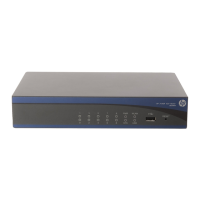Display DSL status information. display dsl status interface atm interface-number
Display DSL version information and
available capabilities.
display dsl version interface atm interface-number
Clear the statistics for an interface. reset counters interface [ atm [ interface-number ] ]
Troubleshooting ATM interfaces
Interface state error
Symptom
The ATM interface state is down.
Solution
Verify that the Rx and Tx ends of the optical fiber are correctly connected.
If the two routers are connected back-to-back, verify that the clock mode is set to master on one interface,
and to slave on the other interface. The default clock mode is slave. To set the clock mode to master, use
the clock master command.
Frequent packet dropping, CRC check errors, and interface
state errors
Symptom
Two routers connecting back-to-back can ping each other successfully. Frequent packet dropping and
CRC errors occur, and the interface state jumps between up and down.
Solution
Verify that the ATM interfaces of the two sides are of the same type, for example, multimode fiber
interfaces or single-mode fiber interfaces. If a multimode fiber interface and a single-mode fiber interface
are directly connected, they can communicate in most cases. However, frequent packet dropping, CRC
errors, and interface state errors might occur.
Troubleshooting DSL interfaces
Improper line operation is one of the faults that you might encounter in DSL applications. Such a fault is
likely to occur on whichever devices or nodes in the hierarchical broadband network architecture. It is
likely caused by the CPE device, copper wire, splitter, DSL port on DSLAM, or the broadband access
server.
On the CPE, follow these steps to troubleshoot the problem:
1. Read the LEDs for the DSL interface card.
When the DSL line is training, the LINK LED blinks. After the activation succeeds, the LINK LED
which should otherwise be OFF lights and stays ON. The Activity LED blinks when data is being
transmitted on the line.
66

